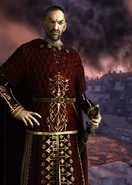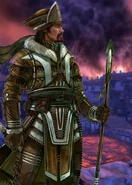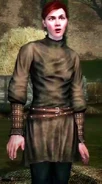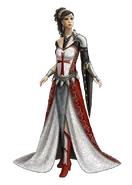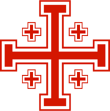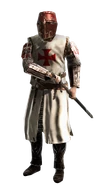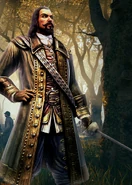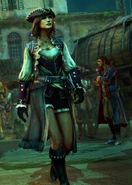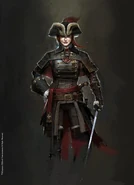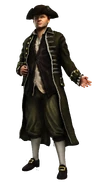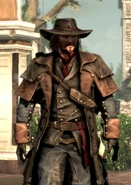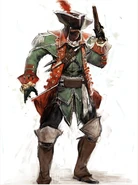- "Our Rite have existed for centuries, and will continue to operate as long as God will it. Some Assassins can not ruin what we have built since the Dark Ages. You may kill each one of us, but we will rise again and again. We will not stop before our duty are fulfilled, and the dawn of the New World will shine bright as day – free from the anarchy you Assassins leave behind wherever you step."
- ―Vendela Magdalene to her killer, 1815
The Dano-Norwegian Rite of the Templar Order is a group of like-minded individuals who swore an allegiance to the Templar ideals, and operated from the 12th century and operates still today. Still, the Rite have had many ups and downs throughout the timeline.
| Dano-Norwegian Templars | |
|---|---|
 | |
| Organizational information | |
| Founder |
Ingólfr Boktark |
| Leader's title | |
| Headquarters | |
| Related organizations | |
| Historical information | |
| Date formed |
c. 1115 |
| Additional information | |
| Notable members |
|
History []
Middle Ages []
Early Middle Ages []
In the early Middle Ages, the founder of the Templar Rite was born: Ingólfr Boktark. Boktark was born some place in Denmark, a son of that time's merchants. With the years passing, Boktark soon became an honorable man. He crossed the sea several times and made contacts with men and women in both Norway and Sweden. At the age of 29, he formed the Danish Rite of the Templar Order. They began to carry out transactions to grow in numbers and grow their influence.
Upon an arrival to Finland, Boktark's right-hand-man – Theobald Pinesvik – came over a special item. It seemed to be a sort of cube. Theobald brought it back to the headquarters in Copenhagen. For the following years, the men and women of the new Rite would try to find out what this device was.
Ingólfr and Theobald expanded their Rite by using a woman named Anna Hundborg. He found men and women who could work for the new-established Templar Order in Denmark.
The Black Death []
1347–1353
In 1347, it was reported of a bubonic plague in the Ottoman Empire that harmed the citizens. The news of the new sickness soon reached all parts of Europe. The Templars knew about it too, but they knew why it happened too: a cube had been destroyed.
Sometime in early 1350, it was reported about incidents from the plague. The Black Death soon covered whole Scandinavia. This was what the Danish Templars had waited for. They had investigated the Cube for centuries and had manage to obtain the knowledge of what it could do: create plagues (and protect one from it), shoot deadly blasts, visualize numbers, and on one occasion it was possible to speak to Loki, a Norse god.
During the Black Death, the Danish Rite's Grand Master, Oluf Bjerg, was taken – just as many of the Master Templars and their allies. But before Oluf died, he pointed out his daughter, Katrina, to be the new leader of the Danish Temlplar Rite. Katarina took the role seriously, and promised to make her father proud of her. She and her brother, Sivert, would be the new masters in the Rite. When the Black Death seemed to leave Scandinavia in late 1350, Katarina used the Cube of Eden to make it flare up again. It was a risk, but Katarina had discovered – after her father's death – that the Cube had the power to protect a given number of people. The only thing that was needed, was that someone had to giver their hand to the Cube – just the hand. The Cube would then infect this hand with particles from the Isu Era. One had to drink a bit of the blood from the hand to prevent being touched by the plague. The First Civilization had created this because they knew the humans would never do it unless they were desperate.
From 1350 to 1353, the Danish Rite of the Templar Order traveled to Norway and killed men and women who would stand in the way for a Danish rule …
(Grand Master)
The Kalmar Union []
1397–1523
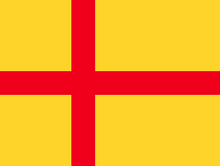
Flag of the Kalmar Union
After the Black Death, Katrina and her acolytes lay plans to create one nation. In 1397 their plan came to a realization. The Kalmar Union was established in 1397 and lasted til 1523. The Templar Order influenced Margaret I of Denmark to be the ruler – and in this way the Danish Rite had the control of three countries. The Kalmar Union was based with the thought that Sweden, Norway and Denmark was to be united under one leader.
The Danish Rite acted like the puppeteers of the Danish monarchy for almost 100 years. When Sweden left the union in 1521, due to Denmark's war with Schleswig, Holstein, Mecklenburg, and Pomerania, the Kalmar Union collapsed. But to still get to know what was happening in Sweden, the Grand Master sent a Master Templar to the Swedish Royals. But the Danes were happy still. Norway was declared a Danish province, and lost all of their influence at the Danish court. The power was now in the hand of Denmark's monarch – and he was under the control of the Dane-Norwegian Templar Rite.
Modern History[]
Danish West Indies[]
1490s–1756
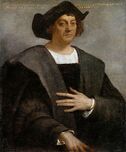
Columbus made the colonization possible
With the discovery of the New World, the Danish Grand Master in 1490s began to lay plans. If the Kingdom of Denmark–Norway – and more important: the Rite – was to survive it's future wars and conflict they would need money. And the New World was the key to this. The Grand Master tasked some men and women to build ships for the Danish Crown. The rest was to suggest for the King that it was time to invest in exploring the world discovered by Christopher Columbus.
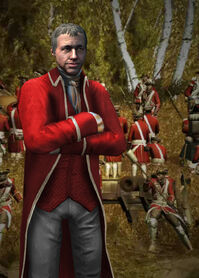
Peter Clausen, 1600s Hospitaller soldiers in the back
As the years passing, so does the Templars. And soon, the Grand Master of the Danish Templar Order, Peter Clausen, is the leader of the Danish West India Company. The Grand Master have got an ally: Konrad Holstein. Konrad was the Grand Master of the Knights Hospitaller. St. Croix was being made to the headquarters for the Knights Hospitaller (the Danish branch), and was protected by Léandre Biniou, a French Templar and military colonel. The island of St. Croix had been in the ownership of the French until 1651, but was removed when the Knights Hospitaller entered. They had control until 1653, when the French returned. After the Frenchmen returned to St. Croix, the Dane-Norwegian Rite could now carry out transactions and military affaires with the French Rite – without getting any consequences. The Frenchmen stayed on Saint Croix for the next years. So, Denmark lost their control, but the Templar Rite got an advantage.
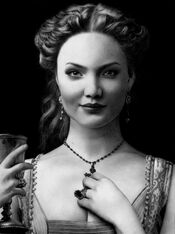
Margaret Kystramme as Grand Master
In 1666, St. Thomas was colonized by Danish settlers. The Danish Grand Master sent a number of agents that was to investigate the geography and find out which advantages St. Thomas could give. When the Grand Master got the news from another Templar in Africa in 1671, he began to think on a trading that could profit for the Danish West-Indies and for the Kingdom of Denmark–Norway. Slave trading. The leader of the West-Guinean Company, Peter Clausen, also received a letter from the King of Denmark–Norway. Peter's company had been active since 1625, but was now officially a company. Peter used this in his advantage and began on the trading of slaves. In 1673, the first ship with slaves entered St. Thomas. The Dane-Norwegian Templars' high-ranked agent, Margaret Kystramme, was not late in encourage into establishing sugar plantations on St. Thomas, due to good soil and warm climate. The profit that would come from the the plantations would be placed in the Fort Christian in the city of Charlotte Amalie.
Saint John was the next island on the list, and Danish settlers came there in 1675. Ms. Kystramme sent some of her Templar agent to Saint John to oversee the settlements and help them grow to plantations. One of the most notable is the Annaberg plantation. Saint John was also the possibility to grow sugar and tobacco. The Dane-Norwegian Templars sent several ships to support their colonies, and then the economy. When the traffic became more difficult to handle on three places, the slaves were sent to Saint John where a high-ranked member of the Order of Malta would take care of the accounting. Afterwards, the ships with slaves was loaded with cargo and sent back to Europe. The slaves was sent to St. Croix and St. Thomas to work – under the supervision of either a member of the Templar Rite or the Order of Malta. In 1681, Grand Master Peter Clausen came to the Caribbean to see what he had achieved. When Peter was done inspecting, and it was just a few weeks before he was to leave, he was killed by a member of the Caribbean Assassins.
With the death of the Grand Master – outside of Denmark–Norway's boarders – the Master Templars in Copenhagen decided to establish a Council. Many had been concerned for the trip, and now their fear had come true. The Master Templars decided to point out a Grand Master for the Council that would lead the Rite in reality, but was to be supported and always surrounded by the Council.
In 1696, the Frenchmen left St. Croix, due to a recession. The French governor was a mastermind in controlling the economy. But when the governor died, so did the economy. The Frenchmen left the island, and it was sold to Denmark–Norway in 1733. Meanwhile – the years from 1696 to 1733 – the new-elected Grand Master, Margaret, had encouraged the Danish Templar agents to find and kill Samuel Bellamy. The man had the Fragment of Eden in his spyglass, and Margaret wanted it before the Assassin got his hands on it. The agents later hired pirate hunters Francis Hume and Alvaro to find Samuel and his new puppet: Alonzo Batilla.
On the island of Saint John, in 1733, the slaves went through a change. They went out in rebellion, led by a the Maroon named King Juni. He was supported by Kanta, King Bolombo, Prince Aquashie, and Breffu. They were all accompanied by the Caribbean Assassin Celeste. The reason for the rebellion was that the slaves had been former members of nobility or the merchants – and they did not want to be slaves the rest of their lives. The Akwamus had plans on running the slave-trading after the rebellion, using other African tribes as their own labour supply. At the eve of 23rd November, slaves came with wood – a usual happening. It was to be delivered at Coral Bay – where a Templar agent was the overseer, a soldier named John Gabriel – and then the slaves was to leave. But before any slave could think of entering the Fort, it was executed a bodily search. This time, the slaves carried with them hidden knives. The soldiers was murdered at the spot, but the gates was still closed. This was little meaning for the Assassin that accompanied them. She climbed the wall and broke it down. The slaves soon killed all members of the Fort. Still, one man escaped: the Templar agent. He was stalked by Celeste to the beach, but here he managed to escape with a fast-traveling schooner. John warned the Danish senior officials about the rebellion. Meanwhile, a group of rebels under the leadership of King Juni stayed at the fort to maintain control; another group took control of the estates in the Coral Bay area after hearing the signal shots from the fort's cannon. The slaves killed many of the whites on these plantations. The rebel slaves moved along to the north shore of the island. Celeste was the one who led them, and she soon found a strange ring, which she later would bring to her Mentor: Ah Tabai. In each area, they avoided widespread destruction of property since they intended to take over the estates and resume crop production for their own benefit.
After gaining control of the Suhm, Sødtmann, and Company estates, the rebels spread out over the rest of the island. The Akwamu attacked the Cinnamon Bay Plantation located on the central north shore. Landowners John and Lieven Jansen and a group of loyal slaves resisted the attack, holding off the advancing rebels with gunfire. The Jansens were able to retreat to their waiting boat and escape to Durloe's Plantation. The loyal Jansen slaves also escaped. The rebels looted the Jansen plantation and moved on to confront whites taking refuge at Durloe's plantation. Defenders repelled the slaves' attack at Durloe's, and many planters and their families escaped to St. Thomas, an estimated 5–9 miles by sea.
The Templar agents sought help by the Knights Hospitaller – who still had some soldiers in Caribbean, stationed in Christiansted, St. Croix – but they did not had the resources after the death of their leader, Konrad Holstein, in 1691. The Council in Copenhagen had still not decided who should be the next leader – since this was an offspring of the original, and belonged to the Dane-Norwegian Rite, the decision was to be taken by them. With no help to get from the Knight Hospitaller, the Templar agents asked for help by their Caribbean brothers and sisters. They got the help they wanted for by the Templar Eugiène Blaise and his wife Claudette. The two Templars located the Maroon hideout in the Danish West Indies: The Carol Bay Fort. After locating the hideout, the Templars began to hunt down the Maroons.
Danish officials appealed for help to French colonists at Martinique, located 324 miles away. Two French ships arrived from there to St. John on April 23, 1734, carrying several hundred French and Swiss troops to try to take control from the rebels. With their firepower and troops, by mid-May they had restored planters' rule of the island. The French ships returned to Martinique on June 1, leaving the local militia to track down the remaining rebels, which they did over the next three months – supported by Danish Templar agents. The slave insurrection was considered ended on August 25, 1734 when Sergeant Øttingen captured the remaining maroon rebels. The loss of life and property from the insurrection caused many St. John landowners to move to St. Croix. Four ships carried planters and their families from Charlotte Amalie in August. While they found St. Croix to be a richer land, they had to have their slaves clear jungle before being able to live there readily.

Franz Claasen
Franz Claasen, a loyal slave of the van Stell family, was deeded the Mary Point Estate for alerting the family to the rebellion and assisting in their escape to St. Thomas. Franz Claasen's land deed was recorded August 20, 1738, by Jacob van Stell, making Claasen the first 'Free Colored' landowner on Saint John.
In 1754, the Dane-Norwegian Templar Rite had established them well, with contacts all over the Caribbean – and with trading active.
War of the Seven Years[]
1754–1763
The war began in 1754 as the result of shifting political borders and alliances in Europe, coupled with the efforts of several nations to secure lands beyond Britain's Thirteen Colonies. The war didn't begin on an international scale until 1756 and ended in 1763 and is where the conflict gets its name, even though it technically lasted for nine years. Fighting soon broke out both in Europe and in and around North America; theaters ranged from Canada to the West Indies and from the eastern Atlantic coast to the Russian city of Moscow. The infamous French and Indian War was part of the conflict, specifically the North American theater, where France allied with native Iroquois tribes to stop the British advance westward. In Europe, the war was largely fought with sieges and arson along with several open battles.
American Revolution []
1775–1783
French Revolution []
1789–1799
Napoleonic Wars []
1803–1815
Removal of Danish West Indies[]
1801–1916
WWI[]
1914–1918
WWII[]
1939–1945
Cold War []
1947–1991
Today[]
1991–Present
Members[]
Templars []
With the Templars pulling the strings in Denmark and Norway over centuries, many – but not all – Templars have made an example of themselves. These men and women are given with their name, their title in the Rite and how many years they spent in it.
European Templars[]
Early Middle Ages
The Danish Rite in it's birth.
- Ingólfr Boktark (Grand Master; 1115–1137) (Council not established)
- Theobald Pinesvik (Master Templar; 1115–1136)
- Anna Hundborg (Master Templar; later Grand Master; 1116–1141)
- Unnamed Templars*
*Note: Women had difficult to be something else than housewives in these times, and therefore the only Templars was men.
Black Death
The Danish Rite during the Black Death.
- Oluf Bjerg (Grand Master; ?–1350) (Council not established)
- Katrina Bjerg (Grand Master (1350); 1350 – 1377) (Council not established)
- Sivert Bjerg (Master Templar; 1343 – 1375)
- Unnamed Master Templars*
- Unnamed Templars
*Note: Women had difficult to rise in the Templar ranks, only women that stood close to high-ranked members had the possibility to become one themselves.
Kalmar Union
The Danish Rite during the Kalmar Union.
- Unnamed Grand Masters (?–?)
- Unnamed Master Templars (?–?)
- Unnamed Templars
Denmark–Norway
The Dane-Norwegian Rite established with the destruction of the Kalmar Union. Members of the Templar Council (Grand Masters and other Council-members) are listed in their own category.
- Gudbrand Aarhus (Templar leader)
- Ivar Horne (Master Templar)
- Tessa Roberts (Master Templar)
- Frey Furaha (Master Templar)
- Eddie Bennun (Templar)
- Hans Sigurdsson (Templar)
- Owen Clemens (Templar)
- Jonas Wenceslas (Templar)
- Olav Olden (Templar)
American stations[]
Danish West Indies Templars
Dane-Norwegian Templars stationed in the Danish West Indies
- Peter Clausen (Grand Master) (Council not established)
- Margaret Kystramme (Grand Master) (Council established)
- Unnamed Master Templars
- Unnamed Templars
- Unnamed Templar agents
- Erich Bredal (Historical character)
- John Gabriel (Historical character)
- Franz Claasen (Historical character)
American colonies
(Gallery)
Dane-Norwegian Templar Council[]
The Dane-Norwegian Templar Council, commonly known as The Council (by the members of this Rite), is working as the modern day's Inner Sanctum. The Council was established when the Order got foothold in different Caribbean and Africa. The members of The Council are today represented with three members. These men and women are given with their name, their role in the Council and how many years they spent there.
- André Lindanger (Grand Master)
- André's father (Grand Master)
- Edmund Kessel
- Frederick Robertson
- Felix Viborg
- Fatima Jawdat
- Margaret Kystramme (Grand Master)
- Urban Vernersen
- Gudbrand Efterår
- Vendela Magdalene (Grand Master)
- Peter von Scholten (Grand Master) (Historical character)
(Gallery)
Allies/Puppets[]
The allies of the Dane-Norwegian Templar Rite was either people never joining the ranks, or members of other Rites supplying and aiding this one. The puppets were individuals controlled by Templars to turn general actions into the Templars' favor.
- Léandre Biniou (Parisian Rite)
- Eugiène Blaise (Caribbean Rite)
- Lord Concord (Louisiana Rite)
- Konrad Holstein (Knights Hospitaller)
- Anna Heegaard (1790–1859) (puppet)
- Alvaro (ally)
- Francis Hume (ally)
- Christian Leberecht, baron von Proeck (puppet) (Historical character)
(Gallery)
Trivia []
- The Black Death was caused by a Cube of Eden's destruction.
- In Norway, Denmark, Sweden, southern part of Finland, and northern part of Germany, the Black Death was orchestrated by the Danish Rite.

